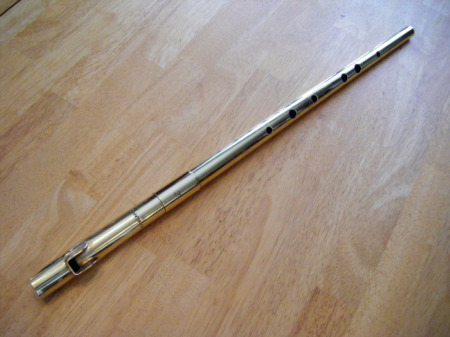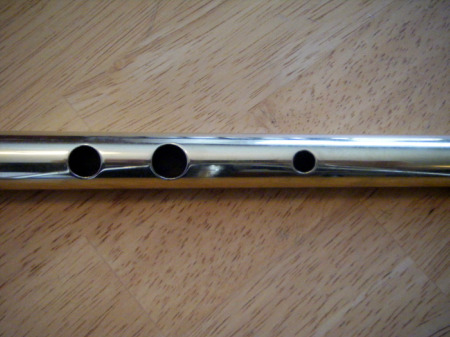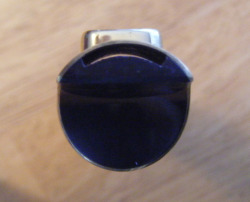Maker - Michael Copeland
Material - Brass or Silver
Dimensions: Length - 22 1/2"
Distance between 1st and 3rd bottom holes - 2 3/4ths"
Diameter of 2nd hole from bottom - 7/16ths"
Bore (at bottom) - 5/8ths"
Weight - 8.5 oz (brass)
Price at time of review - Varies by supply and demand
There
is no doubt that whenever there is a discussion of top Low whistle
makers, the name Copeland will come up. Copeland in my mind is one of
the only make of low whistles that really stands out as being very
different from the original basic Overton design that most other low
whistle brands are based on, having it's own distinct sound, look and
feel. Seamus Egan of the well known Irish band Solas shed a spotlight
on Copelands by using one of Michaels original proto type low D models
in concert almost exclusively. Unfortunately, Michael Copeland is no
longer mass producing whistles, having closed his company "Copeland
Woodwinds" indefinitely. It is rumored that he still makes a whistle
here and there, and still does some repair work, but he was not
accepting custom orders for new whistles at the time of this writing.
This has caused Copeland whistles to become scarce and in high demand,
and they have been known to fetch quite the high price on ebay.




Appearance:
When looking upon a Copeland whistle, one is first struck by the
large visual difference between it and other, more Overton design based
whistles. This is not only due to it's conical bore design, but also it's
large shield or wall built around the window and blade. (It is said
that this wall affects the tone of the whistle and also has the side
benefit of keeping the whistle from cutting out in windy, out of doors
conditions) Copelands are most often seen in Brass, so the color is a
change over the usual aluminum as well. This whistle looks quite
well made and feels quite sturdy. The only visual distraction for me
was that some sauder was visible around the window wall, but this is
likely unavoidable and was at least smoothed out. The tuning slide is
tight, yet works smoothly. The word "copeland" is nicely stamped on the
front of the head of this whistle below the window in a cool celtic
script, and a cursive "D" is engraved on the tuning slide. The
mouthpiece end is closed with a black delrin plug (held in place with
brass pins) which is nicely shaped and very comfortable on the mouth.
The top of the mouthpiece is brass however, and can leave a bit of a
metallic taste in the mouth if you are not carefull. I initially
thought that the conical, smaller bore would make this whistle easier
to finger, but I found that I had to be careful as I often had trouble
keeping the holes well sealed. However, I think this might have mostly
been due to my personally being more accustomed to straight bored, cylindrical
whistles.
Tone: Copelands have a beautiful, distinctive tone that is a bit hard to describe. Some say they have a flute like quality but they also have plenty of chiff and the low octave on this whistle can get quite resonant and "growly". The tone is pure with just enough turbulence/breathyness to make it sound like a whistle. I found this whistle to be very different to play than any other low D whistle I had before in that the tone of the bottom octave was heavily affected by ones embouchure and the shape of the inside of ones mouth while blowing. I found that if I raised the pallet of my mouth a bit and created more space in my mouth, it caused the tone of the whistle to become much more resonant, clear and loud, where if I left the space in my mouth more closed, the tone was flatter and breathier. With proper mouth adjustment, the low D note on this whistle can be quite resonant!
Volume: I would describe the volume of this whistle as being medium to moderate in comparison to other Low D's I have played. The second octave is noticeably louder than the first, which would likely be lost in most session environments.
Backpressure/air requirement:This whistle has a fairly low amount of backpressure, which caused the bottom notes to be a little more touchy than I prefer, as they would break into the second octave quite easily. Add in the effects of embouchure mentioned above, and it was almost like learning to play a different instrument! Air requirement was moderate to high.
Responsiveness: This whistle is nicely responsive with a good snap to ornaments, and as mentioned the tone can be changed on the lower octave by changing mouth shape and embouchure which can be used to great effect. This whistle did demand a high level of attention to breath control and fingering, or else it would definitely let you know it was not happy! But taking the time to learn how this whistle demands to be played is well worth the resulting sound.
Clogging: This whistle did seem to clog a bit for me, and I would have to stop to clear it out. I also occasionally noticed fluid shooting out the window and spattering or running down the front of the whistle.
Tuning: This whistle was well in tune with most notes falling within five cents of true. Only exception was both the first and second octave E's were about 10 cents sharp, but this was really only noticeable on the tuner, not so much audibly. The big issue was, like most other conical bored whistles, I could not find a good, in tune cross fingering for the C natural. Even OXXXOO was twenty cents sharp. Luckily half holing seemed easier due to the small bore width.
Sound clip: I wasn't able to get a recording of the exact whistle reviewed here due to computer issues, but here are a couple links to some youtube videos of people playing Copeland low D's: Planxty Irwin
and here's a clip of Seamus Egan playing his Copeland (starts about a third of the way thru the set)
Summary: This is definately a well made, high quality instrument. As mentioned it has a very different feel than other Low whistles, which can be a double edged sword. While it is nice to have a whistle with a different feel and sound, it can be hard to switch between it and another low D on the fly. This whistle demands that you learn how it wants to be played, and I would recommend that it might be best to have a monogamous relationship with it, rather than trying to adjust between it and the playability of other low whistles. While sound and quality would give this whistle six holes, the rather steep learning curve on it's playability keeps it at a very respectable five holes.

Addendum: I did at one time own another Copeland Low D made from silver, but found it to be almost identical to the brass. Only major difference was that the silver did have a brighter, sweeter sounding second octave, but did not have the same resonance in the first octave as the brass. The only two visual/construction differences were that the brass had a small ring or endcap around the bottom of the whistle that the silver did not have, and the delrin on the mouthpiece of the silver whistle was more smoothly shaped. Playability was identical. I personally preferred the mellower, more resonant sound of the brass.
Tone: Copelands have a beautiful, distinctive tone that is a bit hard to describe. Some say they have a flute like quality but they also have plenty of chiff and the low octave on this whistle can get quite resonant and "growly". The tone is pure with just enough turbulence/breathyness to make it sound like a whistle. I found this whistle to be very different to play than any other low D whistle I had before in that the tone of the bottom octave was heavily affected by ones embouchure and the shape of the inside of ones mouth while blowing. I found that if I raised the pallet of my mouth a bit and created more space in my mouth, it caused the tone of the whistle to become much more resonant, clear and loud, where if I left the space in my mouth more closed, the tone was flatter and breathier. With proper mouth adjustment, the low D note on this whistle can be quite resonant!
Volume: I would describe the volume of this whistle as being medium to moderate in comparison to other Low D's I have played. The second octave is noticeably louder than the first, which would likely be lost in most session environments.
Backpressure/air requirement:This whistle has a fairly low amount of backpressure, which caused the bottom notes to be a little more touchy than I prefer, as they would break into the second octave quite easily. Add in the effects of embouchure mentioned above, and it was almost like learning to play a different instrument! Air requirement was moderate to high.
Responsiveness: This whistle is nicely responsive with a good snap to ornaments, and as mentioned the tone can be changed on the lower octave by changing mouth shape and embouchure which can be used to great effect. This whistle did demand a high level of attention to breath control and fingering, or else it would definitely let you know it was not happy! But taking the time to learn how this whistle demands to be played is well worth the resulting sound.
Clogging: This whistle did seem to clog a bit for me, and I would have to stop to clear it out. I also occasionally noticed fluid shooting out the window and spattering or running down the front of the whistle.
Tuning: This whistle was well in tune with most notes falling within five cents of true. Only exception was both the first and second octave E's were about 10 cents sharp, but this was really only noticeable on the tuner, not so much audibly. The big issue was, like most other conical bored whistles, I could not find a good, in tune cross fingering for the C natural. Even OXXXOO was twenty cents sharp. Luckily half holing seemed easier due to the small bore width.
Sound clip: I wasn't able to get a recording of the exact whistle reviewed here due to computer issues, but here are a couple links to some youtube videos of people playing Copeland low D's: Planxty Irwin
and here's a clip of Seamus Egan playing his Copeland (starts about a third of the way thru the set)
Summary: This is definately a well made, high quality instrument. As mentioned it has a very different feel than other Low whistles, which can be a double edged sword. While it is nice to have a whistle with a different feel and sound, it can be hard to switch between it and another low D on the fly. This whistle demands that you learn how it wants to be played, and I would recommend that it might be best to have a monogamous relationship with it, rather than trying to adjust between it and the playability of other low whistles. While sound and quality would give this whistle six holes, the rather steep learning curve on it's playability keeps it at a very respectable five holes.
Addendum: I did at one time own another Copeland Low D made from silver, but found it to be almost identical to the brass. Only major difference was that the silver did have a brighter, sweeter sounding second octave, but did not have the same resonance in the first octave as the brass. The only two visual/construction differences were that the brass had a small ring or endcap around the bottom of the whistle that the silver did not have, and the delrin on the mouthpiece of the silver whistle was more smoothly shaped. Playability was identical. I personally preferred the mellower, more resonant sound of the brass.